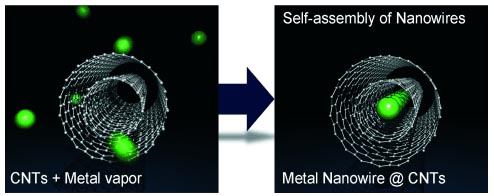Home > Press > Atomic Wire with Protective Sheath
 |
Abstract:
Stable metal nanowires one atom wide inside carbon nanotubes
Atomic Wire with Protective Sheath
Japan | Posted on October 7th, 2009Wires with atomic dimensions are potential structural elements for future nanoscopic electronic components. Such fine wires have completely new electronic properties. However, apart from the non-trivial production of metallic nanowires, their high chemical reactivity is a critical problem; they are easily oxidized in air and are not stable. Japanese researchers working with R. Kitaura and H. Shinohara have now developed a new method that is simple and delivers stable nanowires: They deposit metal atoms inside of carbon nanotubes. As the scientists report in the journal Angewandte Chemie, this forms metal wires of individual atoms lined up side-by-side that are so well protected by their sheath that they have long-term stability.
The method of production simply involves heating carbon nanotubes and a metal powder together in a vacuum. It works for all metals that enter into a gaseous phase at relatively low temperatures, such as europium, samarium, ytterbium, and strontium. The metal atoms almost completely fill the cavity inside the carbon nanotubes. Using europium metal and carbon nanotubes with an inner diameter of about 0.76 nm, the researchers were able to obtain wires made of a single chain of individual atoms. This first true one-dimensional nanowires was also stable after one month of exposure to air.
By using carbon nanotubes with different inner diameters, ultrafine wires with various diameters could be produced, which were for example formed of two or four atomic chains. In comparison to macroscopic europium crystals, the atomic wires demonstrate significantly different electronic and magnetic properties.
The nanowires are an ideal model for the study of one-dimensional phenomena. The researchers now aim to test the properties of the wires with respect to their suitability for use as "wiring" for nanoelectronic components.
Congratulations to V. Ramakrishnan, T. A. Steitz, and A. Yonath on the receipt of the Nobel Prize in Chemistry. Yonath is a member of the editorial board of our sister journal ChemBioChem; current reviews by her are available on request.
Author: Hisanori Shinohara, Nagoya University (Japan),
Title: High-Yield Synthesis of Ultrathin Metal Nanowires in Carbon Nanotubes
Angewandte Chemie International Edition 2009, 48, No. 44, doi: 10.1002/anie.200902615
####
For more information, please click here
Contacts:
Hisanori Shinohara
Nagoya University (Japan)
Editorial office:
or Amy Molnar (US): or Jennifer Beal (UK): or Alina Boey (Asia):
Copyright © Angewandte Chemie
If you have a comment, please Contact us.Issuers of news releases, not 7th Wave, Inc. or Nanotechnology Now, are solely responsible for the accuracy of the content.
| Related News Press |
News and information
![]() Simulating magnetization in a Heisenberg quantum spin chain April 5th, 2024
Simulating magnetization in a Heisenberg quantum spin chain April 5th, 2024
![]() NRL charters Navy’s quantum inertial navigation path to reduce drift April 5th, 2024
NRL charters Navy’s quantum inertial navigation path to reduce drift April 5th, 2024
![]() Discovery points path to flash-like memory for storing qubits: Rice find could hasten development of nonvolatile quantum memory April 5th, 2024
Discovery points path to flash-like memory for storing qubits: Rice find could hasten development of nonvolatile quantum memory April 5th, 2024
Possible Futures
![]() Discovery points path to flash-like memory for storing qubits: Rice find could hasten development of nonvolatile quantum memory April 5th, 2024
Discovery points path to flash-like memory for storing qubits: Rice find could hasten development of nonvolatile quantum memory April 5th, 2024
![]() With VECSELs towards the quantum internet Fraunhofer: IAF achieves record output power with VECSEL for quantum frequency converters April 5th, 2024
With VECSELs towards the quantum internet Fraunhofer: IAF achieves record output power with VECSEL for quantum frequency converters April 5th, 2024
Nanotubes/Buckyballs/Fullerenes/Nanorods/Nanostrings
![]() Tests find no free-standing nanotubes released from tire tread wear September 8th, 2023
Tests find no free-standing nanotubes released from tire tread wear September 8th, 2023
![]() Detection of bacteria and viruses with fluorescent nanotubes July 21st, 2023
Detection of bacteria and viruses with fluorescent nanotubes July 21st, 2023
Nanoelectronics
![]() Interdisciplinary: Rice team tackles the future of semiconductors Multiferroics could be the key to ultralow-energy computing October 6th, 2023
Interdisciplinary: Rice team tackles the future of semiconductors Multiferroics could be the key to ultralow-energy computing October 6th, 2023
![]() Key element for a scalable quantum computer: Physicists from Forschungszentrum Jülich and RWTH Aachen University demonstrate electron transport on a quantum chip September 23rd, 2022
Key element for a scalable quantum computer: Physicists from Forschungszentrum Jülich and RWTH Aachen University demonstrate electron transport on a quantum chip September 23rd, 2022
![]() Reduced power consumption in semiconductor devices September 23rd, 2022
Reduced power consumption in semiconductor devices September 23rd, 2022
![]() Atomic level deposition to extend Moore’s law and beyond July 15th, 2022
Atomic level deposition to extend Moore’s law and beyond July 15th, 2022
Announcements
![]() NRL charters Navy’s quantum inertial navigation path to reduce drift April 5th, 2024
NRL charters Navy’s quantum inertial navigation path to reduce drift April 5th, 2024
![]() Discovery points path to flash-like memory for storing qubits: Rice find could hasten development of nonvolatile quantum memory April 5th, 2024
Discovery points path to flash-like memory for storing qubits: Rice find could hasten development of nonvolatile quantum memory April 5th, 2024
|
|
||
|
|
||
| The latest news from around the world, FREE | ||
|
|
||
|
|
||
| Premium Products | ||
|
|
||
|
Only the news you want to read!
Learn More |
||
|
|
||
|
Full-service, expert consulting
Learn More |
||
|
|
||








